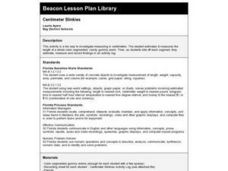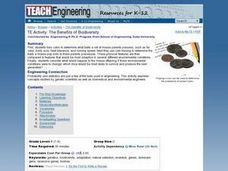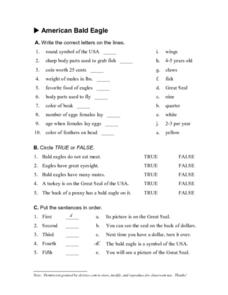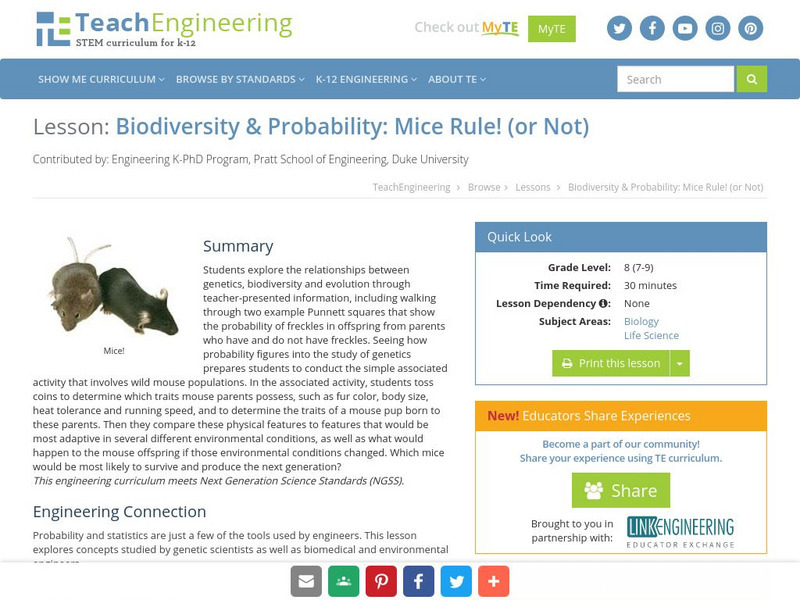Curated OER
Probability
Young scholars explore the concept of probability. In this probability lesson, students perform various probability experiments involving dice, coins, and drawing colored balls from a bag. Young scholars use knowledge of permutations and...
Curated OER
Parts of a Whole
Students recognize coins are worth a fraction of a dollar. They represent the value of different coins by shading in their equivalent fractional parts in the circle. They understand that fractions are part of a whole.
Curated OER
Centimeter Slinkies
Third graders estimate and measure the length of a whole color-segmented, candy gummy worm. Then, as students bite off each segment, they estimate, measure and record findings in an activity log.
Curated OER
Genetics: Mice Rule! (Or Not)
Students explore genetics and evolution by examining a hypothetical mouse population. Using coin tosses, they determine mouse traits of parents and offspring. Finally, they consider the outcomes of changing environmental conditions on...
Curated OER
The Benefits of Biodiversity
Students examine the concept of biodiversity. They toss coins to determine what traits mouse parents have and the babies traits as well. They predict what would happen to the baby mice if the traits of the parents were different.
Curated OER
Fighting Corrosion to Save an Ancient Greek Bronze
Study corrosion on bronze statues with a hands-on lesson. As pupils place a penny in water with salt, they observe the changes in the penny throughout a period of a week. They then analyze the pre-conservation and the...
Curated OER
Getting Better at Guessing
Students, in groups, examine a jar of coins to make both 'guesstimates' and estimates. They compare different estimations and complete a journal entry to summarize their findings.
EngageNY
Conducting a Simulation to Estimate the Probability of an Event II
Add some randomization into simulations. The 11th installment in a series of 25 presents two new methods to use in simulations--colored disks, and random numbers. Pupils use random numbers to run simulations where the probabilities make...
Curated OER
Go West With Columbus
Students play a board game where their tokens must move Columbus west. They choose cards which give commands to move in a coordinate direction. They practice moving west, north, east, south by playing the game.
Curated OER
Fun With Fractions
Students play a math game to gain a better understanding of fractions after visiting the American Revolution in the Time Machine. Students attempt to purchase pies from a local farmer. Students use sheets of paper to show knowledge of...
Teaching Tolerance
The Power of Words: Ethnic Stereotypes
Pupils study stereotypes that are associated with different ethniciites or regional groups. They examine how occupations can be hypothetically related to ethnic sounding names.
Curated OER
American Bald Eagle
In this American bald eagle worksheet, learners match ten facts about American bald eagles with their definitions and put five facts in sequential order.
Curated OER
Charlie and the Chocolate Factory
Fourth graders research and write an author report on Roald Dahl, including books written by him, birthplace, family life, and other information on his writing. Students read aloud chapters in the book. Students create a newspaper...
Curated OER
Sixth Grade Science Test
In this science activity, 6th graders take a multiple choice quiz about matter, properties, electricity, and more. Students complete 30 questions total.
Curated OER
The Power of Words Words That Reinforce Stereotypes
Students devise and discuss definitions for words that are promote stereotypes. They share the definitions and impressions in small groups.
University of Houston
University of Houston: Mathematics Lessons: Counting on Coins
This lesson plan for coin identification is aimed at Kindergarten and First Grade. Lots of activities, suggestions and other resources are also available.
AAA Math
Aaa Math: Value of Coins
Use this interactive game to match the value of a coin with the name of the coin. The game lets you know when you answer an item correctly. Scroll down to view the game.
The Franklin Institute
Franklin Institute: Coin Identification
Two very basic coin identification activities and a teacher lesson plan are available at this website. These activities may require an explanation before primary age students can use them.
Varsity Tutors
Varsity Tutors: Aplusmath: Money Flash Cards
This is a great one-page website for you to practice coin recognition and adding up those coins.
ClassFlow
Class Flow: Money Money
[Free Registration/Login Required] This chart is designed to assess students' prior knowledge of coin recognition and then introduce a technique for adding pennies, nickels and dimes that equal 100 cents or less.
TeachEngineering
Teach Engineering: Mice Rule! (Or Not)
Students explore the relationships between genetics, biodiversity, and evolution through a simple activity involving hypothetical wild mouse populations. First, students toss coins to determine what traits a set of mouse parents...
TeachEngineering
Teach Engineering: The Benefits of Biodiversity
First, students toss coins to determine what traits a set of mouse parents possess, such as fur color, body size, heat tolerance, and running speed. Next they use coin tossing to determine the traits a mouse pup born to these parents...






















